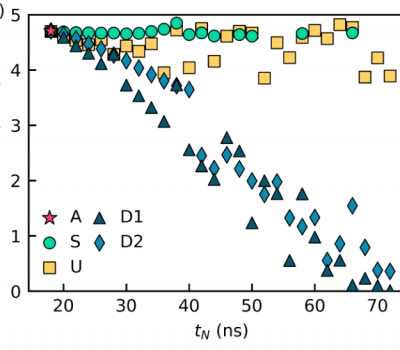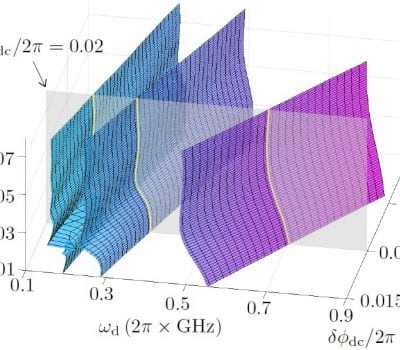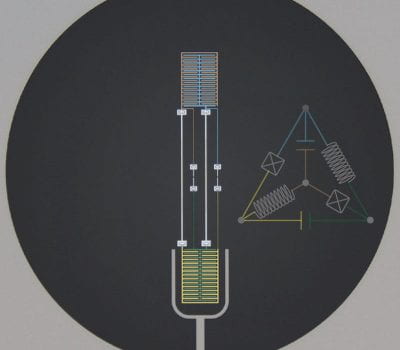Artificial atoms realized by superconducting circuits offer unique opportunities to store and process quantum information with high fidelity. Among them, implementations of circuits that harness intrinsic noise protection have been rapidly developed in recent years. These noise-protected devices constitute a new class of qubits in which the computational states are largely decoupled from local noise […]
Uncategorized
New Phys. Rev. Research Publication: Variational tight-binding method for simulating large superconducting circuits
With our collaborators David Ferguson and Wade DeGottardi of Northrop Grumman Corporation, we have just published in the open-access journal PRResearch a new technique for simulating large superconducting circuits. In this paper we generalize solid-state tight-binding techniques for the spectral analysis of large superconducting circuits. We find that tight-binding states can be better suited for […]
Introducing scqubits: a Python package for superconducting circuits
scqubits is an open-source Python package for simulating and analyzing superconducting circuits. It provides convenient routines to obtain energy spectra of common superconducting qubits, such as the transmon, fluxonium, flux, cos(2φ) and the 0-π qubit. scqubits also features a number of options for visualizing the computed spectral data, including plots of energy levels as a […]
New arXiv preprint: Moving beyond the transmon: Noise-protected superconducting quantum circuits
Artificial atoms realized by superconducting circuits offer unique opportunities to store and process quantum information with high fidelity. Among them, implementations of circuits that harness intrinsic noise protection have been rapidly developed in recent years. These noise-protected devices constitute a new class of qubits in which the computational states are largely decoupled from local noise […]
New arXiv preprint: Variational tight-binding method for simulating large superconducting circuits
We generalize solid-state tight-binding techniques for the spectral analysis of large superconducting circuits. We find that tight-binding states can be better suited for approximating the low-energy excitations than charge- basis states, as illustrated for the interesting example of the current-mirror circuit. The use of tight binding can dramatically lower the Hilbert space dimension required for […]
New arXiv preprint: Robust Quantum Optimal Control with Trajectory Optimization
The ability to engineer high-fidelity gates on quantum processors in the presence of systematic errors remains the primary barrier to achieving quantum advantage. Quantum optimal control methods have proven effective in experimentally realizing high-fidelity gates, but they require exquisite calibration to be performant. We apply robust trajectory optimization techniques to suppress gate errors arising from […]
New Editor’s Suggestion Phys. Rev. Applied publication: Engineering Dynamical Sweet Spots to Protect Qubits from 1 / f Noise
Protecting superconducting qubits from low-frequency noise is essential for advancing superconducting quantum computation. Based on the application of a periodic drive field, we develop a protocol for engineering dynamical sweet spots, which reduce the susceptibility of a qubit to low-frequency noise. Using the framework of Floquet theory, we prove rigorously that there are manifolds of […]
New Phys. Rev. X Publication: Experimental Realization of a Protected Superconducting Circuit Derived from the 0 – π Qubit
In collaboration with the Houck group at Princeton, the Blais group at Sherbrooke, and David Schuster at UChicago, we provided theoretical support to the experimental realization of the 0–π circuit. Encoding a qubit in logical quantum states with wave functions characterized by disjoint support and robust energies can offer simultaneous protection against relaxation and pure dephasing. […]
New Nature publication: Protecting a bosonic qubit with autonomous quantum error correction
We provided theoretical support to our experimental colleagues at UMass Amherst on an experiment demonstrating autonomous quantum error correction. To build a universal quantum computer from fragile physical qubits, effective implementation of quantum error correction (QEC) is an essential requirement and a central challenge. Existing demonstrations of QEC are based on an active schedule of error-syndrome measurements and […]
New Phys. Rev. X Publication: Universal Fast-Flux Control of a Coherent, Low-Frequency Qubit
In collaboration with the Schuster Lab at UChicago, we provided theory support for an experiment studying the heavy-fluxonium circuit. The heavy-fluxonium circuit is a promising building block for superconducting quantum processors due to its long relaxation and dephasing time at the flux-frustration point. However, the suppressed charge matrix elements and low transition frequency make it […]







